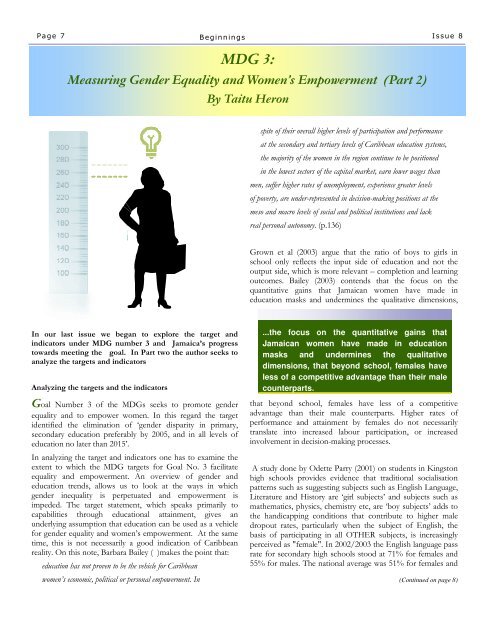Beginnings Issue 8.pub - Planning Institute of Jamaica
Beginnings Issue 8.pub - Planning Institute of Jamaica
Beginnings Issue 8.pub - Planning Institute of Jamaica
You also want an ePaper? Increase the reach of your titles
YUMPU automatically turns print PDFs into web optimized ePapers that Google loves.
P a g e 7 B eginnings I s s u e 8<br />
MDG 3:<br />
Measuring Gender Equality and Women’s Empowerment (Part 2)<br />
In our last issue we began to explore the target and<br />
indicators under MDG number 3 and <strong>Jamaica</strong>’s progress<br />
towards meeting the goal. In Part two the author seeks to<br />
analyze the targets and indicators<br />
Analyzing the targets and the indicators<br />
Goal Number 3 <strong>of</strong> the MDGs seeks to promote gender<br />
equality and to empower women. In this regard the target<br />
identified the elimination <strong>of</strong> ‘gender disparity in primary,<br />
secondary education preferably by 2005, and in all levels <strong>of</strong><br />
education no later than 2015’.<br />
In analyzing the target and indicators one has to examine the<br />
extent to which the MDG targets for Goal No. 3 facilitate<br />
equality and empowerment. An overview <strong>of</strong> gender and<br />
education trends, allows us to look at the ways in which<br />
gender inequality is perpetuated and empowerment is<br />
impeded. The target statement, which speaks primarily to<br />
capabilities through educational attainment, gives an<br />
underlying assumption that education can be used as a vehicle<br />
for gender equality and women’s empowerment. At the same<br />
time, this is not necessarily a good indication <strong>of</strong> Caribbean<br />
reality. On this note, Barbara Bailey ( )makes the point that:<br />
education has not proven to be the vehicle for Caribbean<br />
women’s economic, political or personal empowerment. In<br />
By Taitu Heron<br />
spite <strong>of</strong> their overall higher levels <strong>of</strong> participation and performance<br />
at the secondary and tertiary levels <strong>of</strong> Caribbean education systems,<br />
the majority <strong>of</strong> the women in the region continue to be positioned<br />
in the lowest sectors <strong>of</strong> the capital market, earn lower wages than<br />
men, suffer higher rates <strong>of</strong> unemployment, experience greater levels<br />
<strong>of</strong> poverty, are under-represented in decision-making positions at the<br />
meso and macro levels <strong>of</strong> social and political institutions and lack<br />
real personal autonomy. (p.136)<br />
Grown et al (2003) argue that the ratio <strong>of</strong> boys to girls in<br />
school only reflects the input side <strong>of</strong> education and not the<br />
output side, which is more relevant – completion and learning<br />
outcomes. Bailey (2003) contends that the focus on the<br />
quantitative gains that <strong>Jamaica</strong>n women have made in<br />
education masks and undermines the qualitative dimensions,<br />
...the focus on the quantitative gains that<br />
<strong>Jamaica</strong>n women have made in education<br />
masks and undermines the qualitative<br />
dimensions, that beyond school, females have<br />
less <strong>of</strong> a competitive advantage than their male<br />
counterparts.<br />
that beyond school, females have less <strong>of</strong> a competitive<br />
advantage than their male counterparts. Higher rates <strong>of</strong><br />
performance and attainment by females do not necessarily<br />
translate into increased labour participation, or increased<br />
involvement in decision-making processes.<br />
A study done by Odette Parry (2001) on students in Kingston<br />
high schools provides evidence that traditional socialisation<br />
patterns such as suggesting subjects such as English Language,<br />
Literature and History are ‘girl subjects’ and subjects such as<br />
mathematics, physics, chemistry etc, are ‘boy subjects’ adds to<br />
the handicapping conditions that contribute to higher male<br />
dropout rates, particularly when the subject <strong>of</strong> English, the<br />
basis <strong>of</strong> participating in all OTHER subjects, is increasingly<br />
perceived as "female". In 2002/2003 the English language pass<br />
rate for secondary high schools stood at 71% for females and<br />
55% for males. The national average was 51% for females and<br />
(Continued on page 8)

















